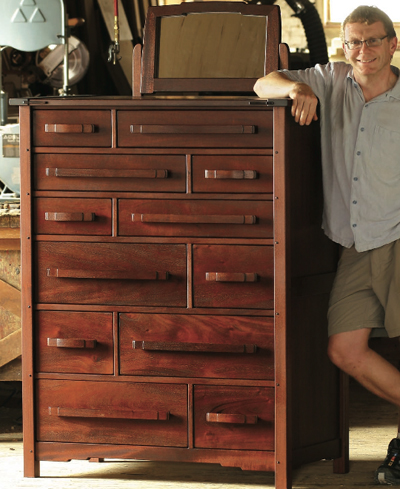
His niche is recreating the styles of the past. Contributing editor Mike McGlynn, a woodworker from Minneapolis, Minnesota, specializes in Prairie School and Arts and Crafts pieces. It’s the linear aspects of these early 20th century designs that appeal to him, along with their solidity.
Furniture design and its details are fascinating for Mike. “Chairs in particular are very satisfying,” he said. “It can get quite complex … making them aesthetically pleasing and still structurally solid. It’s a real challenge.”
Not that he planned to become a furniture designer. He has a degree in political science, and his previous jobs include cabinetry and building wooden boats. About 10 years ago, he opened his shop, McGlynn Woodworking, and eventually moved to a furniture concentration.
“The thing about cabinetry is that, no matter how elaborate you get, it’s still mostly boxes with doors on them,” he said.
Mike learned woodworking from his father, a Wisconsin veterinarian who pursued it as a hobby.
Mike kept at it because it was fun. “At the very base of it, I just like to make things,” he said. “I like to take new lumber and turn it into a nice, aesthetically pleasing piece.” He’s interested in looking beyond the obvious, as well. While most woodworkers associated with the Prairie or Arts and Crafts schools concentrate on Frank Lloyd Wright and Gustav Stickley, Mike points out there were lots of other architects and designers involved. He particularly appreciates the works of Purcell and Elmslie and the Greene brothers. Pieces from Greene and Greene, he explained, were both beautifully made and wonderfully engineered.
Mike does find some time to take on work in other styles. For example, he recently built a 20-foot mahogany conference table with a burl veneer top. As a hobby, he still builds wooden boats, and not long ago he restored an old guitar.
Purcell-Cutts: a Little House in the Prairie
One of the feathers in the cap of this woodworker is the furniture he has designed for the Purcell-Cutts house owned by the Minneapolis Institute of Arts. The home was the personal residence of William Gray Purcell who, with partner George Elmslie, was a well-known Prairie School architect.
Built in 1913, the house was sold to railroad executive Anson Cutts in 1919 and donated to the museum in 1985 by the Cutts children. While the 3,000 square foot house itself was in good shape, most of the furniture was missing. Mike was commissioned to build reproductions – based on two photos – of Purcell’s bedroom set: bed, dressing table, chairs, and a bench for the dressing table.





